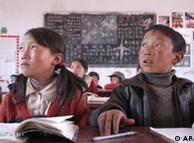這種菜園花園教育 我在四十多年前的大甲國小受過半套 如此而已
Sowing the Seeds of Gardening

George Ruhe for The New York Times
GREENING Lucia Firbas, a fourth grader at Riverside Elementary in Princeton, N.J., tends a garden at the school.
By JACQUELINE MROZ
Published: December 5, 2008
Princeton, N.J.
Skip to next paragraph 
George Ruhe for The New York Times
Joseph Rodrigues, botany teacher at Bloomfield High in Bloomfield, Conn., picks Red Russian winter kale with some of his students.
ASK Maddie Deutsch, a fourth grader at Riverside Elementary School here, what she likes best about her school’s herb garden, and her answer is one rarely heard spoken by a 9-year-old: “I like to eat the pineapple sage. It tastes cool. The lemon sorrel is good, too.”
Welcome to the Princeton School Gardens program. Here, children regularly work in one of the district’s 15 gardens during school hours, preparing garden beds, planting herbs and vegetables and harvesting them when they are ripe. The students eat raspberries from their own raspberry plants, sample cherry tomatoes off the vine and take bok choy, kale and cabbage home to cook and eat.
“We made sure that everything in our herb garden was edible, and when the children go out there, you can see them eating fistfuls of flowers and plants — they’re just munching them right on the spot,” said Dorothy Mullen, a parent who was the driving force behind the school gardens project in Princeton, which started seven years ago.
From Scarsdale, N.Y., to Bloomfield, Conn., to Lawrenceville, N.J., students are getting hands-on lessons in how to plant vegetables, compost and prune. The garden is a year-round commitment, and it is being used to teach subjects like math, science and language arts.
Home gardeners may be cleaning up their beds and putting away their tools for next year. For schools interested in creating a garden program, now is just as busy as in the spring. It is the time to start planning a new garden. It can take months to obtain money, like grants, or to get permission to start a garden from a school district or principal. At some schools, the work is just beginning for students who are growing plants from seeds indoors.
“You can teach almost any school subject through a garden,” said Marc Bouvier, executive director of the Northeast Organic Farming Association of New Jersey. “And a garden is also a wonderful vehicle for kids who don’t do well in traditional classroom settings. For kids who are disengaged in school, we often find that gardens are a place where they thrive.”
The benefits don’t stop there, said Mr. Bouvier. Working in school gardens encourages kids to be physically active and it gets them out in nature. And children who grow their own vegetables are more inclined to eat them. “On every level, it’s such a win-win situation,” he said. “People come out of school gardens feeling very empowered. It really engages people and builds confidence for kids and parents.”
In Princeton, Ms. Mullen and other members of the Princeton School Garden Cooperative wanted to make it easy for their teachers to use the gardens in their classes, so they put together sample lesson plans for various subjects.
For instance, in math, children can learn how to measure the rows in a garden, determine the perimeter of the bed and chart the growth of plants. The cooperative has made all the lesson plans available free at www.prs.k12.nj.us/GardenCoop/, its Web site.
THE district now has gardens in every school, including the middle school and high school. Other schools frequently visit to learn how to put together their own garden programs, and Ms. Mullen offers free workshops on the subject, including how to write grants and tap into local businesses to fund garden projects.
In Scarsdale, a school garden program being run by a nonprofit group takes all the vegetables grown in the gardens during the summer and donates them to the local food bank. Last summer, more than 1,000 pounds of vegetables, including tomatoes, eggplant and broccoli, were donated; organizers hope to triple that number next summer.
“It’s exciting to see kids in Scarsdale — which has one of the best school districts in the country — using nature to give back to the community,” said the aptly named Russell Greenleaf, owner of Greenleaf Gardens, which runs Scarsdale’s four-year-old garden program.
Scarsdale students also host harvest festivals twice a year, using their gardens’ vegetables to make dishes like potato leek soup or eggplant parmigiana, which they eat along with their parents and teachers. Many of the vegetables are also used in the school cafeterias.
And Mr. Greenleaf is planning to plant several apple trees at the schools. One of the elementary schools is built on land that was once an apple orchard, so he found the variety of apples that once grew there. In a few years, he hopes that students will be able to eat apples from their own trees.
It’s the understanding of where the food they eat comes from that many school garden advocates point to as one of the most important advantages of these programs for children.
In Bloomfield, Conn., the high school students work in the school garden in their botany classes, then cook the food that they grow in their culinary arts classes. Much of that food, like winter kale picked last week, is then served in the school cafeteria.
“I don’t think these kids were really aware of where their food came from before,” said Joseph Rodrigues, who teaches botany and environmental science at the high school. “But once they get their hands into the soil and see the fruits of their labor, and then they prepare something, I think it really gets them to change their mind about their food choices. It’s so much better to have them involved in the process rather than just talking to them about it.”


